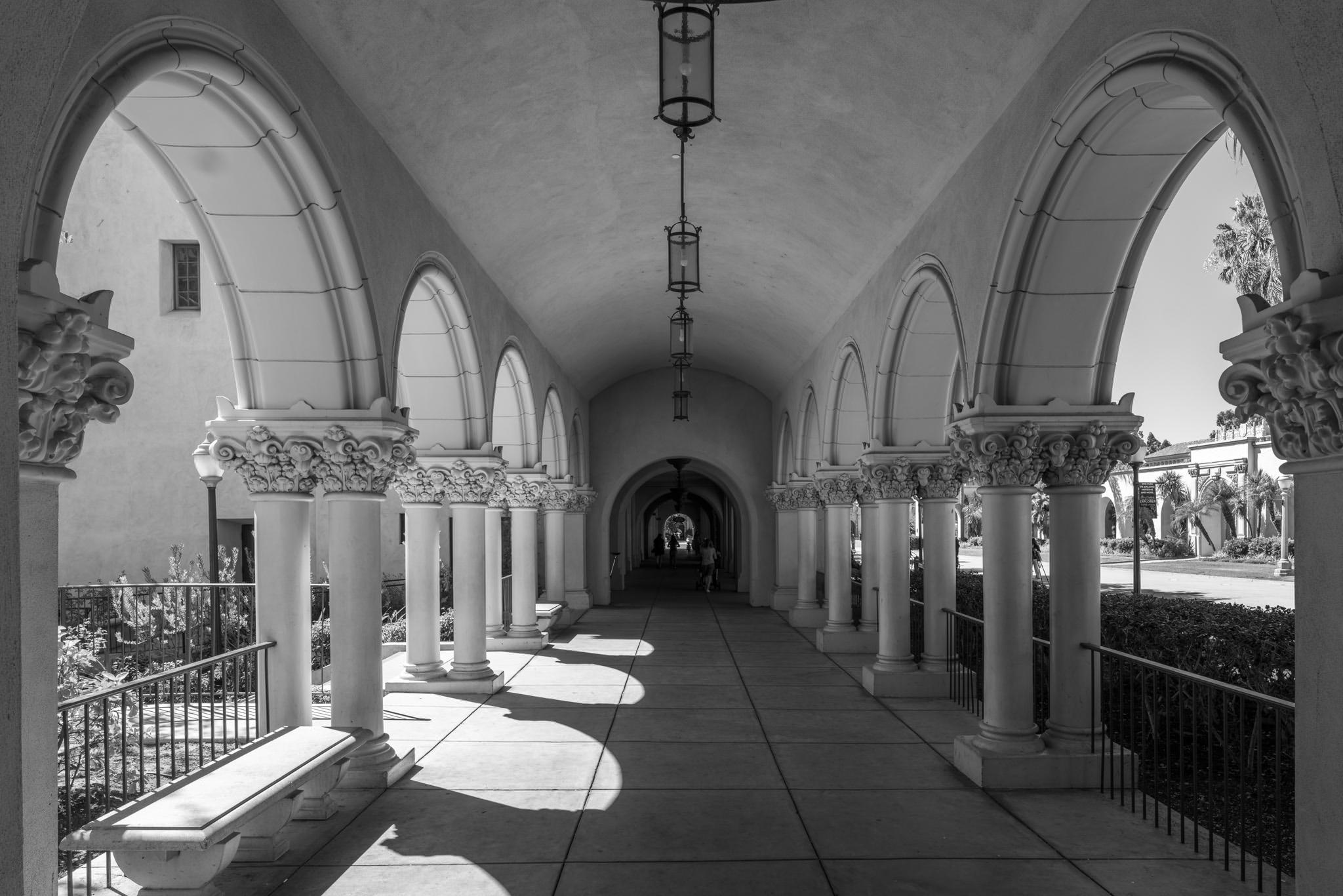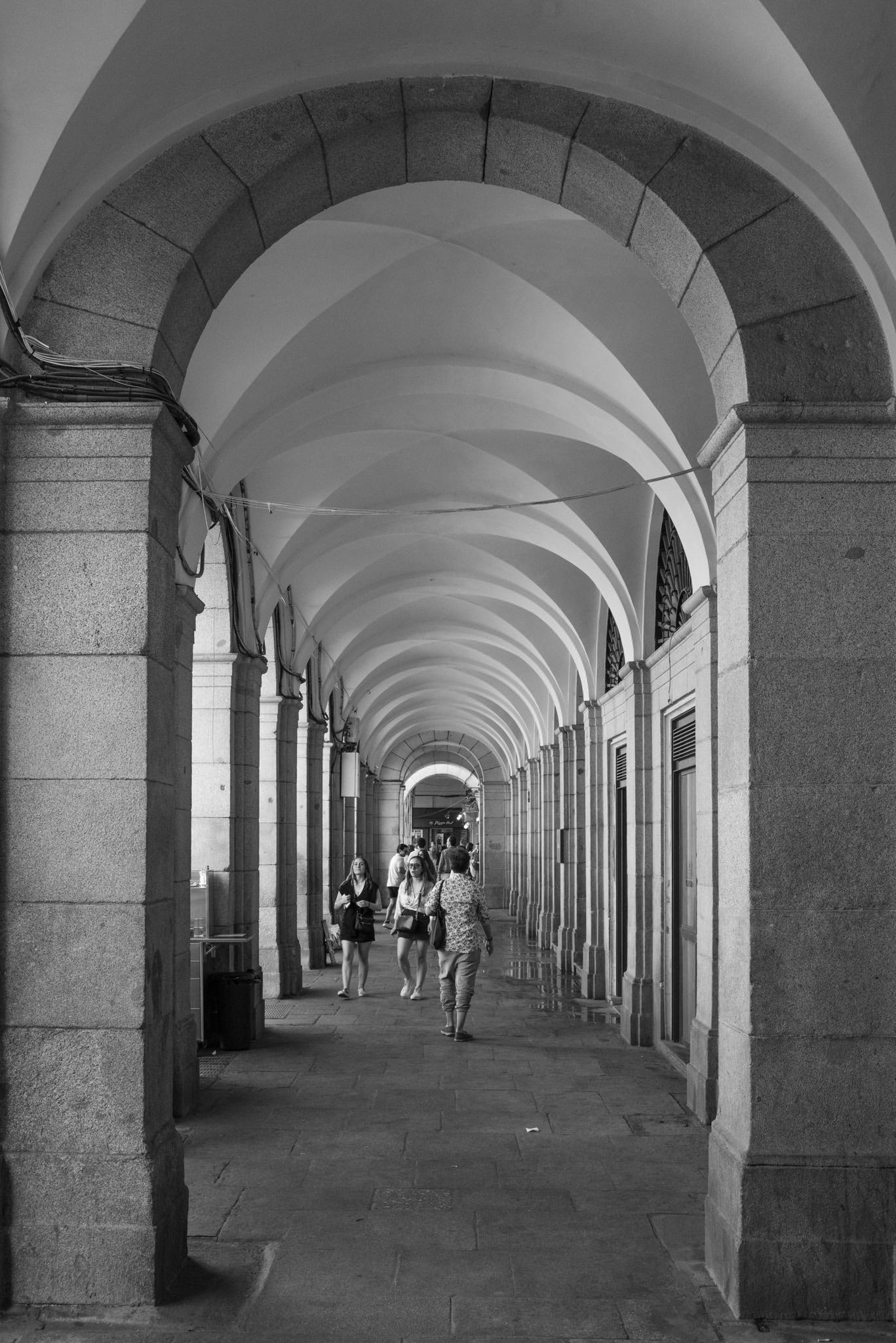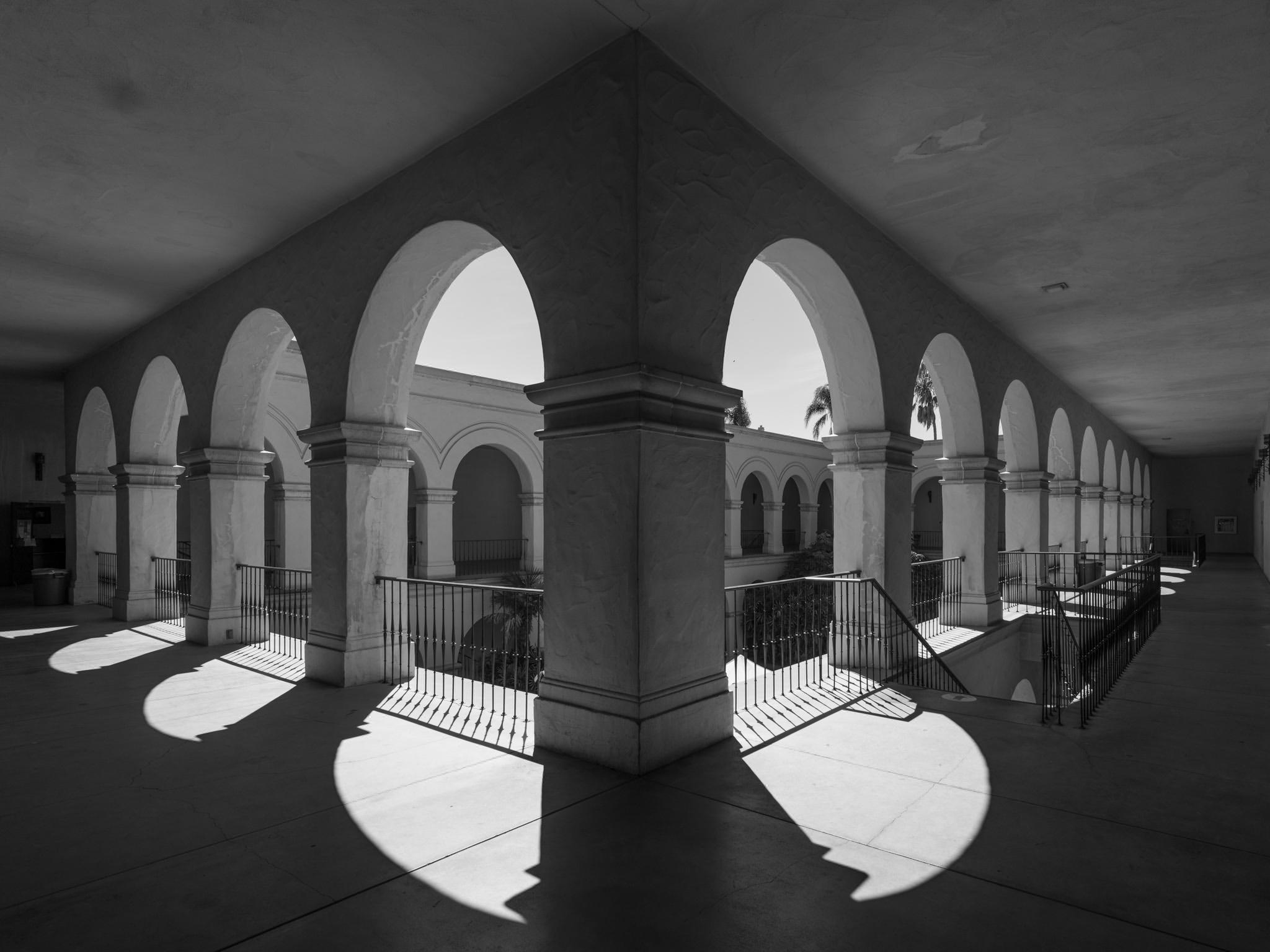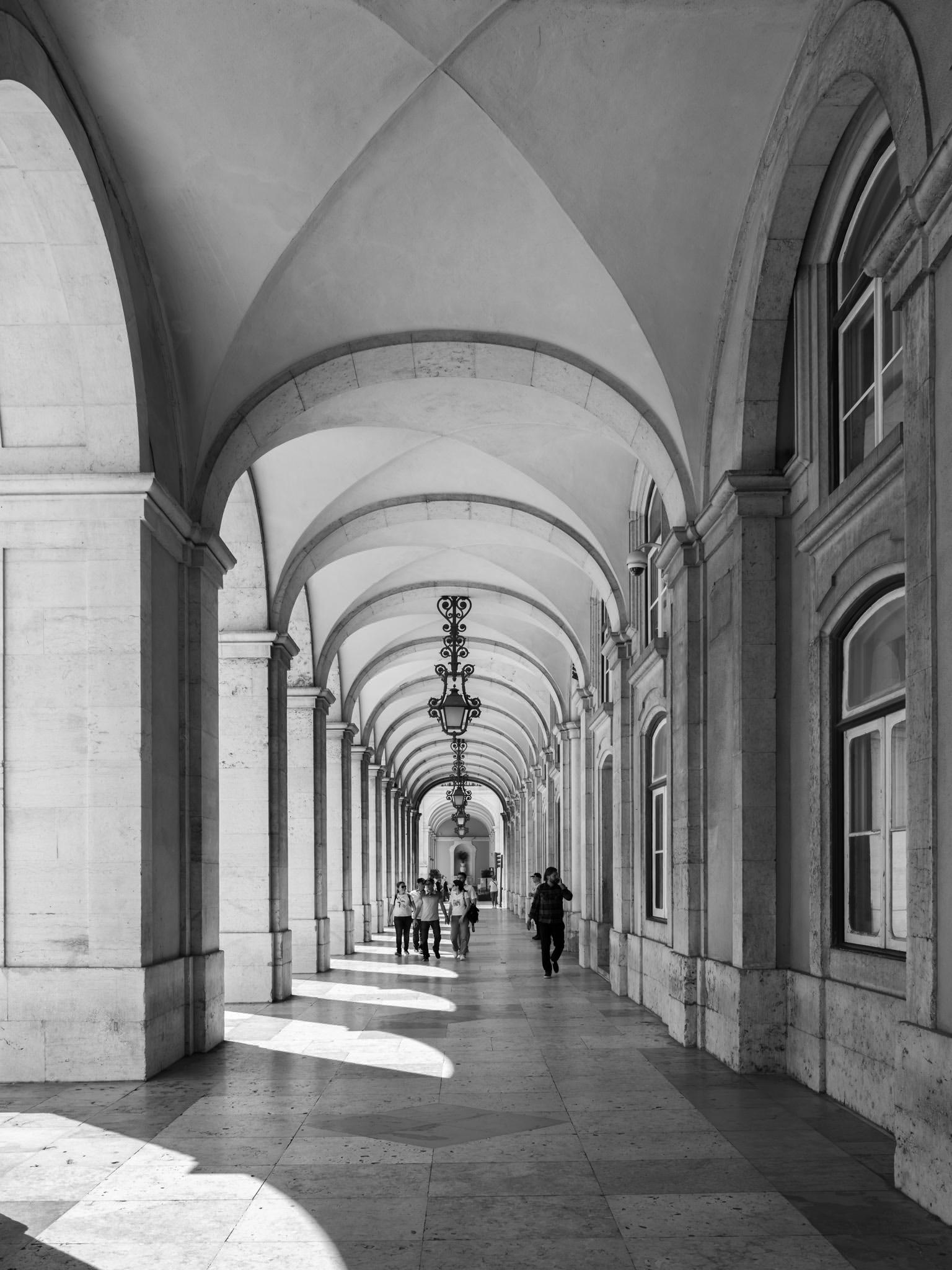Few scenes set my photographic heart aflutter as does the view down a long covered walkway towards a distant, barely visible vanishing point. As a self-confessed symmetry addict drawn to architectural images in black and white, photographing these vistas scratches a deep creative itch. Some might consider my fascination with these architectural features borderline obsessive. By the time you have read this article, you might be among them.
My disorder was triggered by repeated exposure to Spanish Revival architecture in the region where I live — a style enthusiastically embracing these elegant, shaded promenades — and exacerbated by recent visits to Southern European countries shamelessly flaunting their classical architecture.
Although my appreciation had hitherto been primarily aesthetic, the blistering heat and blazing sunshine in those locations brought home the functional benefits of a covered walkway, sheltering pedestrians from the elements as they navigate plazas and courtyards.
Nomenclature
These classic covered walkways are variously referred to as colonnades, arcades, cloisters and porticos. My exploration of this branch of architecture led me to clarify the difference between them and, in doing so, recognise my mischaracterisation of numerous examples photographed to date.
My biggest mistake has been playing fast and loose with the term colonnade. I beg forgiveness from the gods of architecture. As the name suggests, a colonnade is a row of columns (joined at the top by something called an entablature). Strictly, columns are circular in cross-section, and a classical colonnade has two parallel rows.
Sadly, I rarely encounter them in the wild. Ironically, the curved example illustrated here is in my own backyard, one of two adorning the Spreckels Organ Pavilion in Balboa Park, San Diego. Built in 1915 for the Panama-California exposition, the park (mentioned in a previous article) is a feast of Spanish Revival architecture, employing colonnades, arcades and cloisters galore.
A popular variant of the colonnade employs columns in doublets. Above is a petite example inserted into a longer walkway at the junction with a stairway. And below is an internal colonnade with double columns and a spectacular marble floor, to be found in (of all places) the Venetian hotel and casino in Las Vegas. I was not there to gamble.
Arcades then and now
The architectural feature I had been mislabelling as a colonnade turned out to be an arcade, a walkway comprising a series of arches on one side and a wall or shops on the other, above which is a roof.
Arcades enabled citizens to patronise the shops lining the walkway whilst remaining sheltered from sun or rain. As exemplified by the famous Burlington Arcade in London, the term arcade has slowly morphed to encompass any covered row of shops. It is even found these days in the term ‘arcade games’.
Arcades can be of modest vertical and horizontal dimensions, particularly those associated with a local shopping precinct.
Or, they can be grand affairs associated with a palace or seat of government. Some have simple curved or flat ceilings, while others sport ornate ceilings of intersecting curved planes. Suspended light fixtures accentuate the repetitive nature of the arcade, their cadence adding a supplementary harmonic to the vista.
Cloistered existence
And what about cloisters? Does the term bring to mind secluded monasteries and ancient centres of erudition?
I think of cloisters as courtyards enclosed on four sides by arcades, the arched openings to the interior being either floor-to-ceiling or sitting above a low wall. They are perfect settings for outdoor wedding ceremonies, where the bride and groom can make a dash for cover in inclement weather.
Technical challenges
I have encountered three common challenges when photographing these architectural delights: people, contrast and geometry.
The magic of these repetitive sequences of arches derives from their unbroken lines of shadow, retreating gracefully into the distance. While including passers-by provides a helpful reference for scale, too many will clutter the scene and obscure that elongated view.
One strategy for avoiding unwelcome intruders is to wait patiently for a gap in the crowds or for a single individual to appear in the right spot. Patience is a virtue in most endeavours and a prerequisite for architectural photography.
An alternative approach is to visit the scene at a quiet time, for example early in the morning. Unfortunately, the most interesting shadow patterns are sometimes visible only later in the day, when the sun has risen fully and the crowds are out.
Talking of shadows, an intrinsic feature of these structures is the extreme difference in illumination between the surfaces exposed to direct sunlight and those shielded by stonework. This results in gorgeous shadow patterns echoing into the distance, but a challenge in managing the resultant high contrast.
In very bright sunlight, I use exposure compensation to under-expose by at least a stop, confident I can recover the shadow detail courtesy of the superb sensors in my Leica Q2 or SL2, together with post-processing in Lightroom.
The third common challenge is control of perspective. Since photographs of these walkways contain repeating sequences of vertical lines, I strongly prefer images in which these uprights are nearly or perfectly upright.
Most readers are probably aware that Lightroom has an impressive suite of controls for adjusting image geometry. However, aggressive correction of verticals can result in a significant loss of pixels at the lower corners of the image.
I therefore try to take the photograph with the lens-sensor axis as horizontal as possible while capturing as much roof and floor area as I can. This often means pacing back and forth at my chosen spot, taking multiple shots and apologising to people waiting to pass.
Lens choice
I took many of these photographs with a Leica Q2, my travel camera, during visits to European cities. Oriented in portrait mode, the field of view of its 28mm lens was sufficient to capture all the arcades I encountered. When activated in the viewfinder, the crosshairs and horizon line helped frame these highly symmetrical subjects. Tackling buildings closer to home, I used a Leica SL2 coupled with a Sigma Art-series f/2.8 14-24mm wide-angle zoom, permitting the use of landscape mode in several cases.
Posting on Instagram requires cropping photos in portrait orientation to a 4×3 format. This is a nuisance, sometimes making it impossible to include both base of column and ceiling features. Happily, Macfilos embraces photos in their native format.
Contemporary interpretations
The ancient designers of covered walkways who introduced those repetitive arches and columns delivered a functional architectural form with striking visual impact. Can today’s architects match their achievements?
Although we are unlikely to see many new examples replicating these classical structures, modern design can still draw upon the principles of columns, repetition and perspective.
Above is an example from the spectacular T4 terminal of the Adolfo Suárez Madrid-Barajas Airport in Madrid, designed by the architectural team of Antonio Lamela, Richard Rogers and Luis Vidal. The columns may be steel and non-vertical, and the ceiling might incorporate acoustic dampening, but the conceptual resemblance is unmistakable.
Phototherapy
Hopefully, there is a treatment out there for my arcade OCD. In the meantime, I hope to discover more examples of these architectural gems to add to my collection.
Let me know in the comments section if you have come across any arcades I should track down and photograph or if you are afflicted by a similar fixation, perhaps for domes, railway stations or cowsheds. It takes all sorts.
Read more Macfilos articles by the author
More on the Leica Q2
More on the Leica SL2
Join the Macfilos subscriber mailing list
Our thrice-a-week email service has been polished up and improved. Why not subscribe, using the button below to add yourself to the mailing list? You will never miss a Macfilos post again. Emails are sent on Mondays, Wednesdays, and Fridays at 8 pm GMT. Macfilos is a non-commercial site and your address will be used only for communications from the editorial team. We will never sell or allow third parties to use the list. Furthermore, you can unsubscribe at any time simply by clicking a button on any email.
















The Arcade in Cleveland, OH
401 Euclid Avd. Cleveland, OH 44115
https://www.theclevelandarcade.com
Wonderful subject and another proof of your very conceptual work, Keith. As the others wrote, do travel to France, Italy and other European countries if you can. You will find many scenes very much to your taste. Not only in old monasteries, but also in towns with their arcades from the 12th to the 21st centuries. Thanks for sharing this and congratulations on the headline. Flows very nicely.
Hi Joerg-Peter, Many thanks! I enjoy putting together articles that explore specific themes. It helps in selecting photographs to include and in formulating an accompanying narrative. I am drawn to organizing information and lines of thought into a coherent, usually graphical framework. Are you familiar with the Meyers-Briggs personality type? I am an INTJ – which explains this predilection. A photo-essay themed on the Meyers-Briggs framework would be an interesting challenge… 🙂 Cheers, Keith
Oh yes, definitely suffer the same affliction!
https://www.instagram.com/p/CeELq88L-HT/
(Brompton Cemetery, London)
Thanks John! That is a fabulous photo! Glad to know I am not the only one who gets a kick out of these scenes. I shall be following you from now on! Cheers, Keith
Thanks Keith for a great article and a wonderful set of black and white images. These arcades are wonderful to play with light. If you ever venture to France, the romanesque cloisters of the cistercian abbeys such as the 3 sisters in Provence (Sénanque, Silvacane and le Thoronet) and Noirlac gothic abbey in central France are truly wonderful.
Jean
Hi Jean. Thanks so much! It was great fun putting this short piece together. I appreciate the recommendations. I would love to visit the Provence region, and now you have given me another incentive to do so. Which city would be straightforward to reach from Paris, by train or plane, and represent a good base from which to explore the area? Once again, thank for the encouragement and suggestions! Cheers, Keith
Hi Keith,
The easiest city to reach by train is Marseille. From there I’d advise you to rent a car and find a nice central place in the country among the vineyards or fruit orchards. We did stay in Saint-Saturnin-lès-Apt which was quite central to explore north and south of Provence. Driving on B road is not fast but really rewarding.
Jean
Keith
Thank you for an engaging article on a simple theme. Your black and white images certainly enhance the shapes and curves of the arcades and colonnades.
What will be your next theme be?
If you come to the UK again, I would direct you to see the cloisters of our mediaeval cathedrals, such as at; Winchester, Worcester, Salisbury and Norwich.
Chris
Hi Chris, thank you! My next trip to the UK will likely include Oxford or Cambridge on the itinerary, and I know of one or two cloisters there I shall be tracking down. Regarding the next theme, Mike and I have already cooked up another article which we are likely to see sometime in the next few weeks. More architecture, but this time in color! All the best, Keith
Think you should visit Trappist, Benedictine,or Carmelite Monestaries in California, it’s obvious in another life you were a monk.ha
Yes, but Tibetan. Having that far I look for peace in Romanesque gargoyles, make a try. Maybe one day I’ll go to Malibu
Great suggestion John! I had a quick look on Google maps and there are a few ‘monasteries’ within reasonable driving distance. I will be calling ahead to enquire whether they do indeed have cloisters. If there is such a thing as reincarnation, I can think of worse things to have been than a monk! Cheers, Keith
That’s good. Cloisters? Don’t think of that like places of imagination. Next time in Europe don’t miss the many Romanesque clausters to visit here and there.
Thanks George! Cheers, Keith